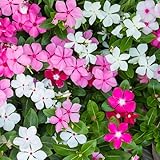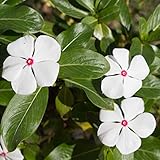Looking for another gorgeous and interesting ornamental plant to have around? Madagascar Periwinkle is waiting for you to bring it home and it has a lot to offer! Its lovely appearance makes it just perfect as bedding and border plant, ground cover, or even potted in eye-catching containers or hanging baskets. Read on to find out more about this low-maintenance plant.
Catharanthus roseus a.k.a Madagascar Periwinkle is an evergreen species of flowering plants in the Apocynaceae family. This lovely and colorful plant is commonly known by many names including the Madagascar Periwinkle, Bright Eyes, Graveyard Plant, Cape Periwinkle, Old Maid, and Pink or Rose Periwinkle. Until today, only two varieties have been recognized: C. roseus var. roseus and C. roseus var. angustus.
Although Madagascar Periwinkle plants are native and endemic to Madagascar, you can find them growing almost anywhere worldwide as both ornamental and medicinal plants. Yes, their flowers bring a spectacular display during the warmer months, but they have a long history of cultivation for their herbaceous properties.
In Ayurveda, the traditional Indian medicine, the extracts of their shoots and roots were used to treat several diseases. Moreover, in Chinese traditional medicine, they worked as an excellent treatment for malaria, diabetes, or Hodgkin’s lymphoma. Nowadays, Madagascar Periwinkle plants are an important source of the drugs vinblastine and vincristine, and people use them to treat various types of cancer.
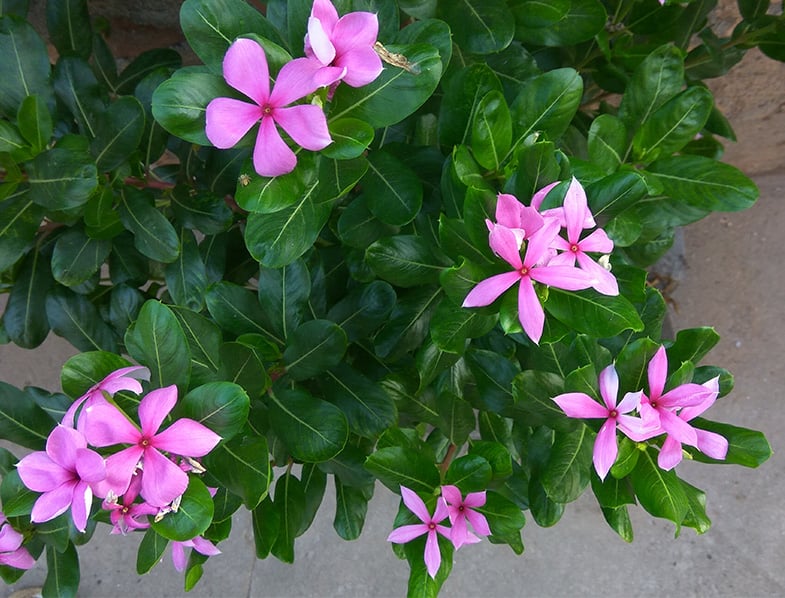
About Madagascar Periwinkle
- In the wild, these shrubs thrive in a wide range of environments. They grow on limestone soils and sand in the forest, grassland, woodland, and disturbed areas.
- The flowers produced by Madagascar Periwinkle plants are highly attractive to many species of pollinators like butterflies and moths. The seeds are often dispersed by ants, water, and wind.
- Thanks to their easy-going style and large color palette, they make for great companions to plants like Dracaena Spikes, Dusty Miller, Lobelia, or other Catharanthus species.
- In the United Kingdom, C. roseus plants have gained the prestigious Award of Garden Merit for their stunning appearance and medicinal importance.
- To grow healthy and bloom sporadically, they need lots of sunlight and warmth all-year-round. These plants cannot tolerate frost but will do just fine in partial shade.
- Madagascar Periwinkles grow at a pretty fast pace, so they require repotting once every six to eight weeks to thrive. When repotting, always choose a container that is one size larger than the current one.
- During their blooming period, these plants will benefit from regular fertilizing. However, too much fertilizer will result in showy foliage, but fewer flowers.
- C. roseus plants are pretty toxic if ingested or smoked. If you have curious pets or children around, grow these flowers in a spot where they cannot reach them.
Madagascar Periwinkle Features: An Overview
- Madagascar Periwinkle plants belong to the Catharanthus genus that contains exactly 8 species of flowering plants. They were formerly included in the Vinca genus and named Vinca rosea.
- They are perennial sub-shrubs or small herbs that can reach between 12 and 39 inches (30-100 cm) in height. The base is somewhat woody, but sometimes sprawling.
- Their foliage consists of oval to oblong leaves that are glossy green, and 1 to 3.5 inches (2.5-9 cm) long. The leaves grow oppositely arranged in pairs on green to dark red stems.
- Both the stems and leaves are usually pubescent, meaning they contain many tiny hairs. Some specimens can be hairless or lose their puffy appearance with time.
- Gardeners value C. roseus plants for their long blooming period which can last throughout the year in tropical areas. In warm temperate climates, they will exhibit flowers from spring to late autumn.
- Their tiny and hairy flowers are born individually or paired on very short stalks. They typically have five petals and come in different shades of pink, purple, orange, red, or white with a darker red center on some varieties.
- Once their flowering period has ended, the blossoms are followed by pairs of fruits. They are follicles, dry fruits that have one compartment and open only along one side when reaching maturity.
- The fruits contain numerous small black seeds that can be used in propagation. The seeds germinate better if you sow them indoors, three to four months before the last frost.
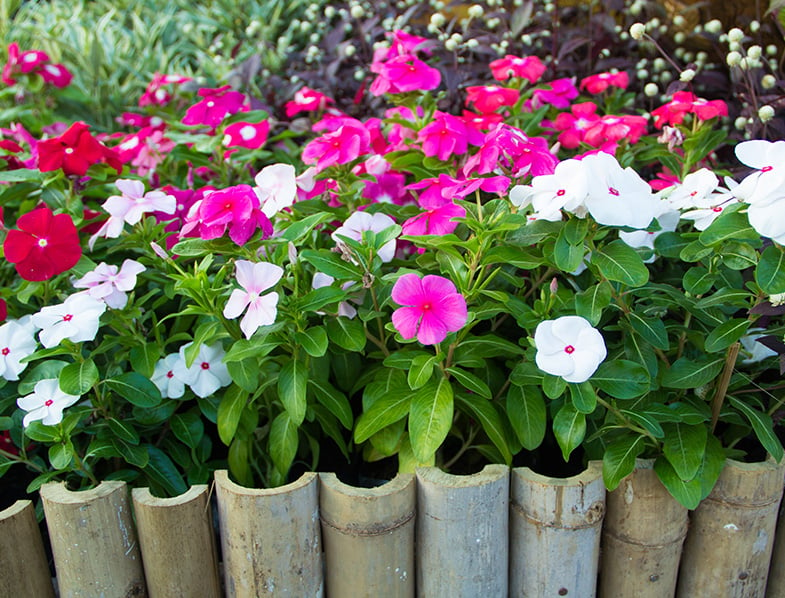
Growing Madagascar Periwinkle
Catharanthus roseus plants usually thrive in locations with bright and indirect light but will prefer some partial shade in hot climates. For optimal blooming, you must also provide your plants with at least three to four hours of direct sunlight daily.
In general, Madagascar Periwinkle plants do well as houseplants in average room temperatures. Outdoors, these tender plants can only withstand temperatures down to 50 °F (10 °C). If you live in a region with harsh winters, plant your babies in pots and bring them inside when the temperatures get too frosty.
These beauties are prone to a few fungal infections, such as leaf spots or aster yellows, but they can be treated easily with suitable fungicides. Also, the most common pests that can bother your Catharanthus roseus plants are snails and slugs. If you notice any suspect presence on your plants, remove the pests and the unhealthy parts, then apply an appropriate molluscicide.
Planting Madagascar Periwinkle
Although Catharanthus roseus plants are dwarfs, you should grow them in a roomy location to allow their luxuriant foliage and flowers to show off. When planting your shrubs, make sure you keep a distance of 12 inches (30 cm) between each specimen.
Catharanthus roseus plants grow healthy and happy in soil that has excellent drainage. The perfect growing mediums for these flowering shrubs are sandy or loamy soils but look for those that are not very fertile. You can also plant them in a potting mix designed for flowering plants.
Madagascar Periwinkle plants are not heavy feeders by nature, but they require some attention during their blooming period. Feed your plants with a balanced liquid fertilizer once every month from early spring to late fall.
- PRETTY PERIWINKLE: Beautiful and long blooming annuals that have a variety of colors. A great garden or container grow.
- EASY TO GROW: Plant the seeds in good soil 1/2 inches deep after the last frost has passed. Or start them indoors earlier.
- MADE IN USA: Hand packaged and Shipped for CZ Grain. From Iowa.
- GROW OR GIFT: For mom, dad, him or her, this is the perfect gift to give on birthdays, anniversaries, holidays, housewarming or any other occasion. Ideal for beginners, masters, and children alike. See the excitement in their eyes as they experience growing indoor bonsai trees.
- CZ GRAIN GUARANTEE: Satisfaction Guaranteed. Message us if there are any issues for a fast and easy solution. CZ Grain specializes in exotic and rare plants to grow.
- [QUALITY SEEDS] The quality of seeds is considered as an important factor for increasing yield. The use of our quality seeds helps greatly in higher production per unit area to treat your table to all-natural, great tasting, homegrown nutrition. Quality seeds have the ability for efficient utilization of the inputs such as fertilizers and irrigation.
- [100% NON-GMO SEEDS] Say goodbye to GMO seed-grown plants you’d buy at the grocery store. With Kira Seed, we only sell non-GMO seeds, and we’re proud to be your source of professionally grown, certified seeds. These seeds are grown under the standards, ensuring the highest quality seeds cultivated from rigorously tested soil treated with only approved fertilizers.
- [GROWING GUIDE] Learn everything you need to know about planting, growing, and caring for the most popular vegetables, fruits, herbs, flowers, shrubs, and houseplants around! In each Growing Guide that printed in the beautiful pack, we’ve identified planting depth, plant spacing, crop period, bloom time, sun exposure, soil type, sprouting and harvesting tips, and additional features.
- [PERFECT PACK FOR GIFT] Giving seeds as gifts is a wonderful surprise for the gardeners in your life. DIY seed gifts needn’t be expensive, but they’re always welcome.
- [24/7 SUPPORT] In fact, nearly half of our customers consider 24/7 support, in real-time a top component of good customer service. Our customers increasingly prefer to communicate with us the same way they do with friends and family: asynchronously. Our Customer Support Team ensures that a customer is able to get their issue resolved no matter what day or time it is.
- Vinca Rosea is not shy about flowering during the heat of summer. This little annual can flower continuously for months no matter how hot the temperatures climb.
- Periwinkle grows an as annual plant in USDA zones 3 0 10 reaching heights of 8 - 10 inches.
- Periwinkle easily establishes from ground cover seeds, and it is especially useful for the southern or desert climates or hard to maintain hot spots near a concrete wall or driveway.
- This variety features white blooms that are 1 - 1 1/2 inches across, 5-petalled and have a carmine center. Vinca Little Bright Eyes is ideal for containers, window boxes, in the bed, and as a general ground cover plant. No deadheading is needed to keep the blooms coming!
- Sowing Rate: 2 - 3 seeds per plant or approximately 2,000 seeds covers 50 square feet when planting it as a ground cover.
Last update on 2024-09-27 / Affiliate links / Images from Amazon Product Advertising API
Watering Madagascar Periwinkle
Compared to other species of flowering plants, watering Catharanthus roseus plants is piece of cake! With these plants, you will have no reason to worry about how often you should water them. Your watering schedule depends on the region you live in or the environmental conditions in which you grow your Catharanthus roseus. These plants are very easy-going and will forgive their busy or forgetful owner without hesitating!
However, natural factors like sunlight or weather can change the frequency of watering, so you must pay attention to your plants once in a while. To avoid over-watering or keeping your plants thirsty for too long, make sure you check the soil in-between waterings. If the soil has dried out completely, then this is the perfect time to provide your plants with a nice soaking.
Drainage is an important factor when it comes to water Madagascar Periwinkle plants. If you want to grow them indoors, choose a pot with drainage holes at the bottom to allow the excess water to drain properly. After watering, remove the water from their tray to avoid soggy conditions or waterlogging around the roots.
Propagating Madagascar Periwinkle
Catharanthus roseus plants have a secret way through every gardener’s heart. Their puffy foliage and delicate flowers are a great addition to any decoration, being it indoors or outdoors. When the warm season comes along, these flowering plants will also be the best gift for your family members or friends. You just simply cannot lose the chance to have more of these beauties around you or your loved ones!
Luckily, Madagascar Periwinkle plants can be propagated through cuttings much easier than you might imagine. The cuttings will respond well to propagation if you take them from new growth in late spring or summer. Also, try to cut them off just below a leaf node and measure about 2 to 3 inches (5-8 cm) in length.
Once you’ve taken the cuttings, you must dip their cut end in rooting hormone before planting. For the growing substrate, fill a medium-sized container with a well-draining potting mixture and water the soil until it becomes damp. The cuttings require protection from direct sunlight and a little extra humidity to grow properly, so enclose them and the pot in a plastic bag.
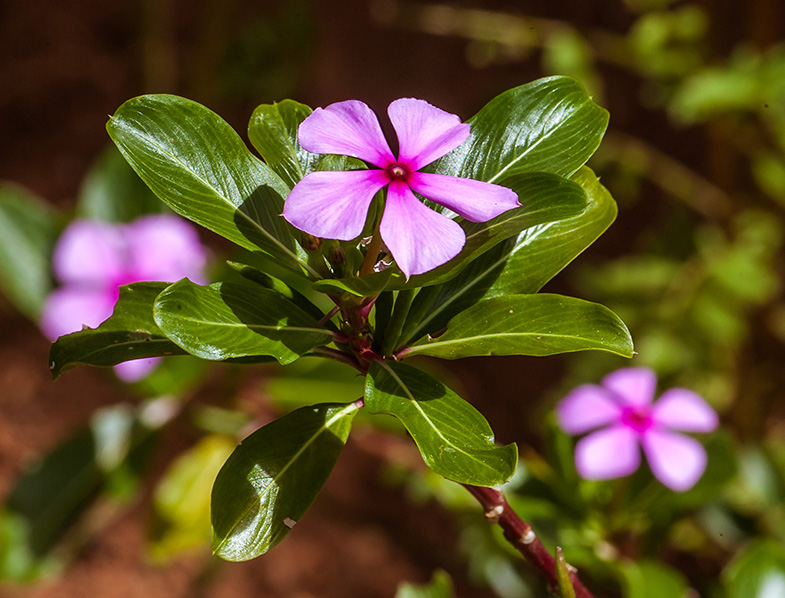
Your baby plants will develop a strong and healthy root system in three to four weeks after planting. After this period, you can transplant them into their individual pots and treat them as mature plants.
You can also propagate Catharanthus roseus plants through seeds. It’s best to sow them in late winter or early spring. Plant the seeds in a moistened rooting mixture, cover the container with a plastic bag and place it in a location with bright, filtered light. Once the germination occurs, in 2-3 weeks, you can uncover the pot and provide the seedlings with water anytime the soil is entirely dry.
In Conclusion
Having plenty of flowering plants in your garden during the warmer season is great! Not only do Catharanthus roseus plants look superb, but they also come along with very few demands. We know, these lovely shrubs might not be the most long-lived houseplants, but they really worth all the effort because they will reward you with their blooms.

